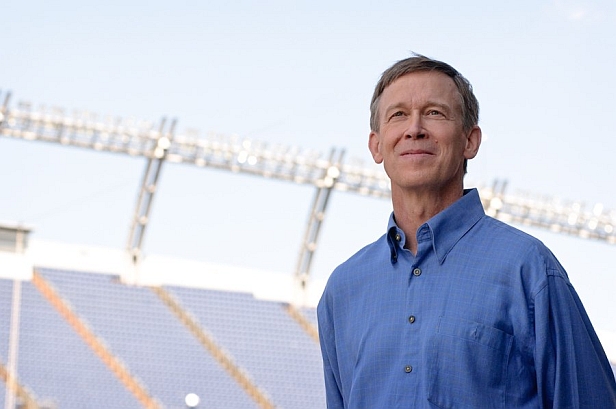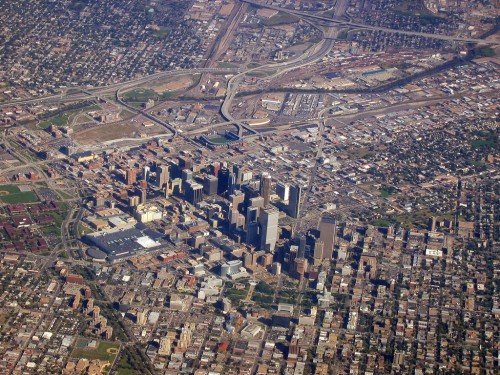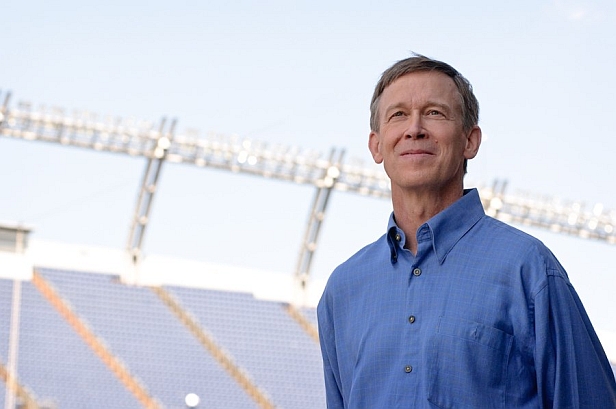 Denver Mayor John Hickenlooper took Transportation Secretary Ray LaHood on a bike ride last week to show off B-cycle, the city’s new bike-sharing program. Hickenlooper has helped lead one of the nation’s most ambitious transit expansions in recent years, the FasTracks plan that would send rail and bus lines further into the Denver suburbs.
Denver Mayor John Hickenlooper took Transportation Secretary Ray LaHood on a bike ride last week to show off B-cycle, the city’s new bike-sharing program. Hickenlooper has helped lead one of the nation’s most ambitious transit expansions in recent years, the FasTracks plan that would send rail and bus lines further into the Denver suburbs.
Hickenlooper is also running for governor of Colorado and is expected to handily win the Democratic nomination on Aug. 10. He’ll likely face Republican Scott McInnis, a former member of the U.S. House (unless McInnis is forced out by a plagiarism scandal). Right now, polls have the two running neck and neck. [Update: Tea Partier Dan Maes upset McInnis in the Republican primary; the race is now between Hickenlooper, Maes, and American Constitution Party candidate Tom Tancredo.]
Q. Is a bike-sharing program of 400 bikes mainly a feel-good measure, or is there evidence that it can cut driving rates and improve livability?
A. We’ve been doing this since three months ago, and we’ve had 42,000 rides, more than 75,000 miles ridden. That’s 2.1 million calories burned. If you include the daily, monthly, and annual memberships, we have about 14,000 memberships.
Q. How does that track with expectations?
A. Pretty much right on. The annual memberships are a little low, but we wanted to roll this out and then expand it. One of the great things about bicycle sharing is that it allows you to link transit stations and people’s places of business. It allows people to easily get across downtown without finding a place to park and spending all that money.
 Q. When you run a city like Denver that’s largely built around driving, are you limited to making tweaks to that model? Or are there ways to significantly get people driving less?
Q. When you run a city like Denver that’s largely built around driving, are you limited to making tweaks to that model? Or are there ways to significantly get people driving less?
A. It’s going to take a long time. This country’s in love with automobiles — that’s not going to go away quick. But we can give people more options. As more people become conscious of health, air quality, the billions of dollars we send to foreign dictatorships to import oil … all these elements suggest to someone that, all things being equal, you’d want to be on a bike.
It’s like cell phones versus landlines. If you told people 10 years ago that landlines would disappear as fast as they are, they wouldn’t have believed you.
Q. The Denver area is one of the few regions extending light rail and bus networks right now. What are you learning from that?
A. Again, the key is to make sure people have choices. People say nobody wants to live in downtowns in Western cities, because people want yards. But we built over 25,000 condominiums and homes in downtown Denver in the last 15 years. If you lay [transit] out right, people will change their ways.
Q. Let’s talk about your campaign for governor. Colorado is a participant in the Western Climate Initiative [a regional cap-and-trade system of seven states and four Canadian provinces], but it’s only an observer state, not one that’s planning to join the carbon auction in 2012. Should the state be a full member?
A. I don’t know enough details yet. I’d have to go look at that. Our legislature last year passed a new renewable energy standard that says we will have to be at 30 percent renewable energy by 2020. That’s pretty ambitious.
Q. Regional climate plans become more important now that the Senate has failed to pass a carbon cap this year. Do you see these programs playing a useful role until we get federal action?
A. Again, I’m being quite frank, I don’t know enough about how they actually work.
We’ve tried to focus on making sure our buildings are weatherized, on getting fleets that are much more fuel efficient. At the federal level, changing CAFE standards is going to have a monumental impact on our carbon emissions.
Q. What’s the biggest thing you’d like to do for the state to clean up its energy supply?
A. We should continue what we’re doing. We’ve looked at old legacy coal plants that are terribly inefficient. We’re going to transform several of those into natural gas-fired [plants]. The improvement to the air and carbon emissions is dramatic.
Q. The energy page of your campaign site considers wind, solar, natural gas, and coal all together. I’d suggest there’s a large difference between wind and solar and “clean” coal, which is nowhere close to market ready —
A. Well, here’s my point. I don’t disagree. But just because it’s not market ready, let’s not divide the landscape into winners and losers. Let’s look into prioritizing how we can get cleaner air and reduce our emissions as much as possible, and not get caught up in the hyperbole. If somebody makes a breakthrough — you can never tell when it happens — and can suddenly burn coal as cleanly as we can burn natural gas, this world will become a dramatically better place, right?
Q.When you talk about transportation and energy, what’s the message you want to communicate to voters?
A. I try not to look at it in terms of any one thing. Climate change is important, but let’s look at the other things. It’s about clean air and the environment, it’s about national security. How many billions of dollars do we send to foreign governments that are likely to be, if not against us, then not with us? And when you look at the amount of money households can save by weatherizing their houses, it makes household budgeting more secure.
It becomes about creating a new economy. Gov. [Bill] Ritter [D] went a long way to demonstrate these new industries are going to create a lot of jobs. If we’re going to convert our energy system over the next 25 years, it’s going to take a lot of not just new entrepreneurial activity, but also just hard work.
Do you know more about this race? Tell us in comments below. And find out about other races in our Gubernatorial Tutorial special series.



